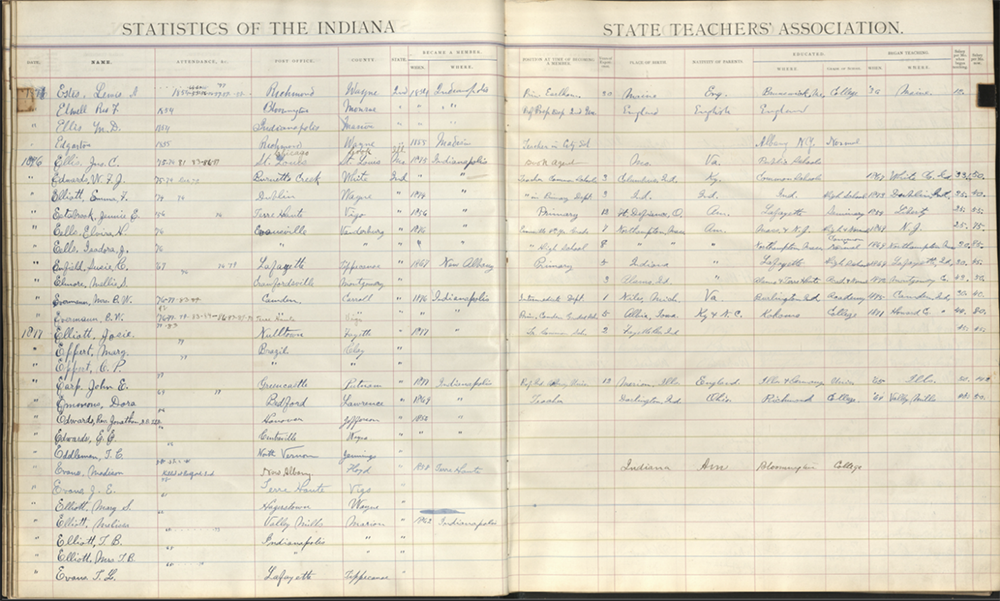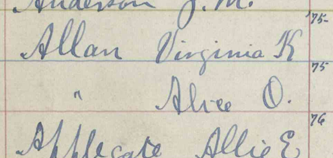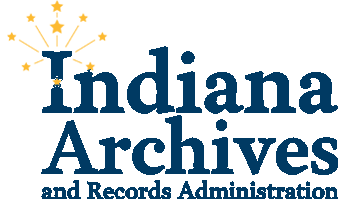
Post by IARA Archivist Josh Koepke
November 2024
Recently, the Indiana State Archives completed a major transcription project! The Indiana State Teachers Association (ISTA) Register Project sought to increase access to a source of names and professional information on thousands of ISTA members from a period between 1871 and 1895. Sources from this period of Indiana education are uncommon and provide glimpses into the lives and activities of individual schoolteachers during a time of change. This register has enduring value through its genealogical and historical significance and highlights the work and professional characteristics of female teachers in Indiana during the nineteenth century.
The volume selected was well suited for transcription. Laid out as a series of spreadsheets of ISTA members sorted in alphabetical order by surname, the register contains a wealth of professional information on individual members as seen in the image below. Each row of the spreadsheet lists one member, while the 18 column headers ask a variety of questions from basic membership dates and location when joining, to professional qualifications like years of experience, starting and current salary and position, and highest level of education obtained. Professional positions of members range widely, including teachers, principals, superintendents, professors, city trustees, students, and even one name simply listed as “have never taught.” So many columns are present that each complete page, of which there are 173, is in fact two pages: the back of the preceding page and the front of next page. Given all this information, the 4616 names present within the register was a high priority for digitizing, transcribing, and indexing.

Setting up this transcription project was unique. Unlike many of our other transcription projects, this register was not previously microfilmed and had to be manually digitized by staff. When the Archives possesses a microfilm version of a record, we can digitize the microfilm quickly with assistance from our State Imaging and Microfilm Lab. In this case, one of our imaging experts, Jenna Auber, digitized the volume. Afterwards, the subsequent files had to be combined for efficient transfer onto our transcription platform of choice, FromThePage. Once uploaded, the transcription design was created before the public could transcribe. The project officially launched on September 29th, 2023, in connection with other Archives Month festivities, and wrapped up initial transcription in June 2024. After public-facing transcription was over, comments and pages flagged for review were examined by staff. Adding the finalized names to our index, Indiana Indexes, is the last step in every one of our transcription projects.
An important resource for many avenues of historical research, the ISTA Register is perhaps most valuable as a genealogical resource. Critically, this project contains a concentrated presence of women, often a rarity for genealogical resources from the period. Beyond the basics of first and last names, entries within the volume supply other valuable genealogical information. In particular, the columns listing “Place of Birth,” “Nativity of Parents” may assist with filling out larger family trees by giving clues to where to search for ancestors, whereas the “County” and “Post Office” columns assist greatly in further genealogical research on a listed individual. While most listed individuals are concentrated within Indiana, plenty of names involve locations of residence outside of Indiana; some of these include Kentucky, Michigan, Missouri, Ohio, New York, and Pennsylvania. With all this data, the genealogical research possibilities abound!
Rivaling in importance is the historical value of the volume. The earliest membership dates documented in the register stretch back to within two decades of the founding of the ISTA in 1854 and the creation of the new state constitution in 1851 which secured the future of centralized public education within Indiana.1 While taken for granted today, many of the fixtures of modern education, like unified grading and curriculum and formalized teacher education in Indiana evolved from the very names listed. Moreover, specific names of historical note dot the freshly transcribed pages. Many of the most prominent Hoosier educators of the day are recorded within the register. These include several presidents of Indiana higher education institutions: F. A. Friedley of DePauw College, Thomas D. Holmes of Union Christian College, A. C. Shortridge and Emerson E. White both respectively of Purdue University, and W. F. Yocum of Fort Wayne College. Additionally, Richard W. Thompson’s name appears; the Secretary of the Navy under President Hayes and a former member of the U.S. House of Representatives, Richard Thompson spent some of his early years as a teacher in Lawrence County, Indiana. A transcriber also noted the appearance of Alice O. Allen (spelled Allan), one of the first five women to enroll in Indiana Asbury College, later renamed DePauw College, and a prominent figure within Kappa Alpha Theta.2 Further examination of the data could turn up more exciting finds!

Zachariah M. Anderson also appears within the register; Anderson attended the Indiana State Normal School (later Indiana State University) in 1870 and is believed to be the first Black student. 3 According to the ISTA register, he later attended Oberlin College, where he studied Latin. His wife Sarah was also a teacher; while she wasn’t a member of the ISTA, we have located her name in the Board of Education’s licensing files.
Additionally, this project provides interesting opportunities to further research the topics of early Indiana women teachers and the professionalization of the teaching profession. The history field recognizes the lack of investigation and scholarly writings on early female educators in Indiana, especially those with limited educational background, lower socioeconomic class, and minority identities.4 More broadly, through the register’s documentation of the education level of its teachers and their current positions, future researchers could also examine the rapid increase in college education attainment by female teachers across the state and the often undocumented experiences of small town, one-room schoolteachers.5 With the materials transcribed, conducting important research into these scholarly avenues is more accessible than ever.
Notes
[1] Indiana State Teachers Association. Advancing The Cause of Education: A History of the Indiana State Teachers Association, 1854-2004 (West Lafayette: Purdue University Press, 2004), 11.
[2] “Alice Allen Brant,” Kappa Alpha Theta. 2024. https://www.kappaalphatheta.org/heritage/our-heritage/our-founders/alice-allen-brant.
[3] Crystal Mikell Reynolds, “A Survey of the African American Experience at Indiana State University 1879-1975: A Pictorial Timeline.” 2024. https://lost-creek.org/genealgy/documents/msp-AA-Book-History-2014-for-Web.pdf
[4] Nancy Gabin, “Fallow Yet Fertile: The Field of Indiana Women’s History,” The Indiana Magazine of History (2000), 237; William J. Reese, “Indiana’s Public School Traditions: Dominant Themes and Research Opportunities,” The Indiana Magazine of History (December 1993): 307.
[5] Patsy Parker, “The Historical Role of Women in Higher Education,” Administrative Issues Journal, 5(1), 7; Reese, 293-294, 304-305.

